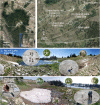Addition of dissolved inorganic carbon stimulates snow algae primary productivity on glacially eroded carbonate bedrock in the Medicine Bow Mountains, WY, USA
- PMID: 37222475
- PMCID: PMC10289208
- DOI: 10.1093/femsec/fiad056
Addition of dissolved inorganic carbon stimulates snow algae primary productivity on glacially eroded carbonate bedrock in the Medicine Bow Mountains, WY, USA
Abstract
Snow is a critical component of the Earth system. High-elevation snow can persist into the spring, summer, and early fall and hosts a diverse array of life, including snow algae. Due in part to the presence of pigments, snow algae lower albedo and accelerate snow melt, which has led to increasing interest in identifying and quantifying the environmental factors that constrain their distribution. Dissolved inorganic carbon (DIC) concentration is low in supraglacial snow on Cascade stratovolcanoes, and snow algae primary productivity can be stimulated through DIC addition. Here we asked if inorganic carbon would be a limiting nutrient for snow hosted on glacially eroded carbonate bedrock, which could provide an additional source of DIC. We assayed snow algae communities for nutrient and DIC limitation on two seasonal snowfields on glacially eroded carbonate bedrock in the Snowy Range of the Medicine Bow Mountains, Wyoming, United States. DIC stimulated snow algae primary productivity in snow with lower DIC concentration despite the presence of carbonate bedrock. Our results support the hypothesis that increased atmospheric CO2 concentrations may lead to larger and more robust snow algae blooms globally, even for sites with carbonate bedrock.
Keywords: algae; carbon; isotopes; nitrogen; phototroph; primary productivity; snow.
© The Author(s) 2023. Published by Oxford University Press on behalf of FEMS.
Conflict of interest statement
None declared.
Figures





Comment on
-
Summer Dynamics of Microbial Diversity on a Mountain Glacier.mSphere. 2022 Dec 21;7(6):e0050322. doi: 10.1128/msphere.00503-22. Epub 2022 Nov 7. mSphere. 2022. PMID: 36342146 Free PMC article.
References
-
- Apprill A, McNally S, Parsons R. Minor revision to V4 region of SSU rRNA 806R gene primer greatly increases detection of SAR11 bacterioplankton. Aquat Microb Ecol. 2015;75:129–37. 10.3354/ame01753 - DOI
-
- Arias P, Bellouin N, Coppola E. “Climate Change 2021: the physical science basis. Contribution of Working Group I to the Sixth Assessment Report of the Intergovernmental Panel on Climate Change; technical summary.” 2021. https://www.ipcc.ch/report/ar6/wg1/(1 February, 2023, date last accessed).
-
- Bahadori M, Wang J-T, Shen J-Pet al. . Soil organic matter and geochemical characteristics shape microbial community composition and structure across different land uses in an Australian wet tropical catchment. Land Degrad Dev. 2021;33:817–31. 10.1002/ldr.4174 - DOI
-
- Bekker A, Karhu JA, Eriksson KA. Chemostratigraphy of paleoproterozoic carbonate successions of the Wyoming Craton: tectonic forcing of biogeochemical change?. Precambrian Res. 2003;120:279–325.

